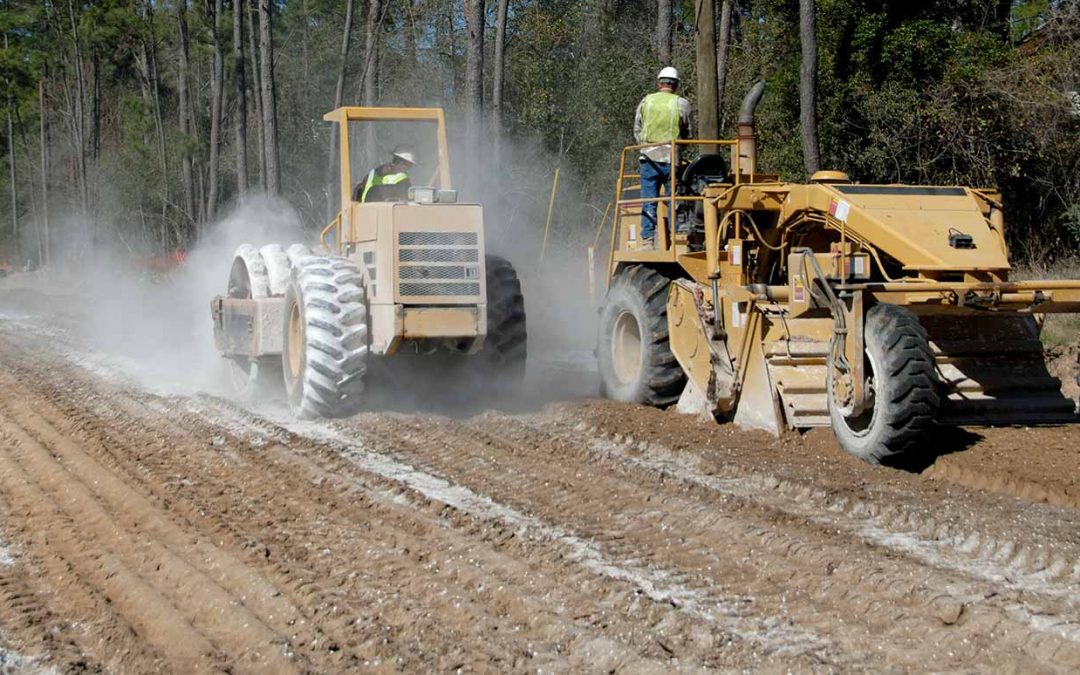The calcium from the lime reacts with aluminates and silicates solubilized from the clay. Cement Application 30 5.
Soil Stabilization Lafayette Dirt Sand Gravel 337 342 5600
Design procedures of ARRA FDR203.

. Construction Field Inspection and Testing 29 Construction 29 Equipment 29 Construction Process 29 1. The type of soil used in stabilization should be of reactive type soil. X lime air lime.
Mix the soil wit h chosen percentage of lime and cu re for 72 hours. Preliminary Grading 30 4. When adequate quantities of lime and water are added the pH of the soil quickly increases to above 105 which enables the clay particles to break down.
Volume Change 20-30 Clay Content 25-30. Fly ash shall be mixed with the soils in increments of 10 15 and 20 by dry weight. From residential streets to the most demanding highways and airfields lime has proven to be the best solution for solving the problems of the high plasticity clay soils and inadequate base materials.
Prompted by possible future withdrawal of HA74 Treatment of Fill and Capping Materials using either Lime or Cement of Both. 30931 Lime Stabilization Mix Design. Achievement of Optimum Moisture Content 33 7.
Improvements include increasing the dry unit weight bearing capabilities volume changes the performance of in situ subsoils sands and other waste materials in order to strengthen road surfaces and other geotechnical applications. E For Lime Pretreatment. Moisture Conditioning If Necessary 29 2.
The proposed mix design shall be prepared by a testing laboratory under the direction and control of a registered rofessional p engineer. Determining the amount of lime necessary is part of the design process and is approximated by tests such as the Eades and Grim test ASTM D6276. The compaction of mixes shall be completed within 2 hours of mixing.
Each blend of the mixture shall be tested per standard Proctor to determine their respective maximum dry densities. Ground qu icklime calcium oxide hydrated lime calcium hydroxide dry or in slurry form and milk-of-lime suspension. Steps for Mixture Design and Testing for Lime Stabilized Soil Step 1 Initial Soil Evaluation Purpose.
Use ASTM C136 10 procedures to determine the amount of soil. 303 Strength requirements for stabilization and modification The reaction of a soil with quick lime or cement is important for stabilization or modification and design methodology. Perform mix design to determine the improvement of engineering properties at varying concentrations of selected additive.
Evaluate key soil characteristics as an initial step to determine if it is suitable for lime stabilization. Compile Mix Design Report 28 Chapter 5. Place plant cuttings in a tight configuration with stem to stem contact so plants extend beyond the next gabion facing by 1 foot and beyond the back of the wall in contact with native soil.
Use the mix design procedure for lime stabilization to determine the percent required to stabilize the material. Use the mix design procedure for lime stabilization to determine the percent required to stabilize the material. Which means the soil should react with lime content when added.
Construction sites in Texas often. Mix the soil with chosen percentage of lime and cure for 72 hours. The mix design shall be determined using the.
A new technical and best practice guide. NO Proceed with construction. Evaluate the overall improvement and durability of the enhanced engineering and material properties.
The mix design shall be the baseline measure for the rate of lime stabilizing agent water additives and corrective aggregate blended with the existing materials to construct the reclaimed mixture. Up to 10 cash back Generally soil stabilization is a method of improving soil properties by blending and mixing other materials. Do the improved properties meet minimum project requirements and goals.
When dealing with these typesoils always recommend lime stabilization to the outside edges of the shoulders. Factors affecting lime-soil stabilization are as follows. Plasticity Index 15-18.
Lime flocculating clay 3. Choose a lesser percentage than the percent required for stabilization. When lime stabilization is recommended the soil support value SSV may be raised to 35 or.
Factors Affecting Lime-Soil Stabilization. For over five decades lime has been utilized to improve and stabilize roadway soils throughout the state of Texas. The form of the lime to be added to the mixture.
Initial Pulverization If Necessary 30 3. E For Lime Pretreatment. Determine the group classification of the lime.
However not a HA74 replacement as in addition to highway works it covers a wide scope of soil stabilisation. The reaction between the lime and soil produces stable calcium silicate hydrates and calcium aluminate hydrates. To stabilize soil and generate long-term strength gain lime is added to reactive soil to cause a pozzolanic reaction.
Grade above the final row of plant cuttings with select clean fill to a slope no steeper than 2 horizontal to 1 vertical. LEVEL 2 MIX DESIGN Vibratory Compaction Cure at Optimums φ150mm h127mm ITS equil and ITS soak LEVEL 3 MIX DESIGN NO Vibratory Compaction Cure at Optimums φ150mm h300mm Triaxial monotonic MIST wet triaxial FINALISE MIX SELECTION DETERMINE DEMAC AND CERTAINTY YES YES NO Done Optimise bitumen content Check ITS results. Choose a lesser percentage than the percent required for stabilization.
Before commencing lime treatment work the Contractor shall submit for approval by the Engineer a proposed mix design. The methodology shall be based on an increase in the unconfined compression strength test data. How lime stabilizes soil.
Soil Stabilization Lime Stabilization Servicesconcrete Of Houston

Lime Soil Stabilization Method And Factors Affecting It The Constructor

Soil Stabilization With Lime Cement Anese
![]()
What Is Soil Stabilization Soil Stabilization Methods Types Of Soil Stabilization

Lime Vs Cement Which Soil Stabilization Method Is Better Mintek Resources

0 comments
Post a Comment